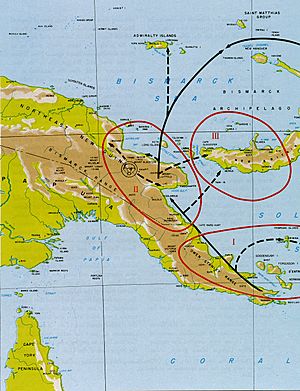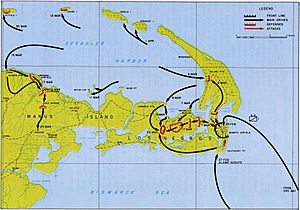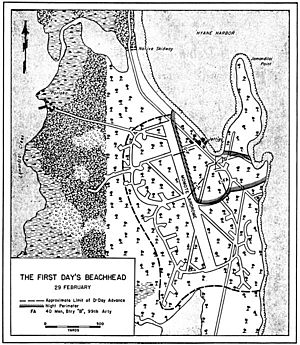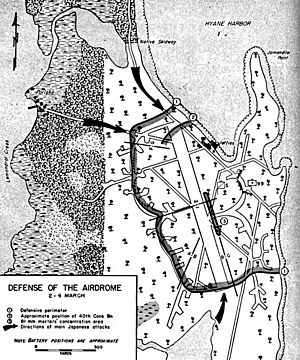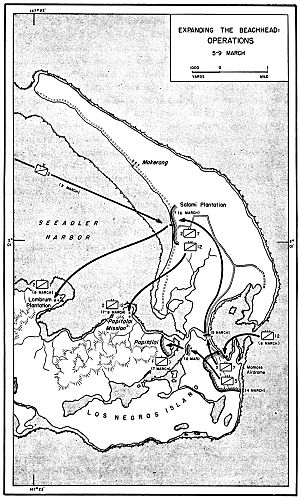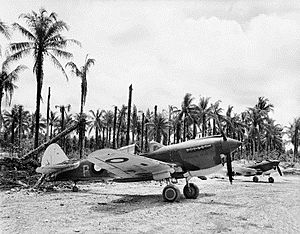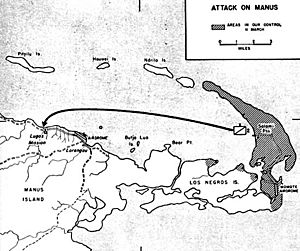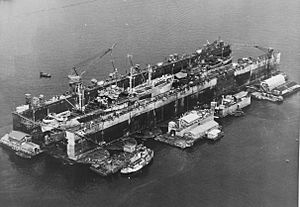Admiralty Islands campaign facts for kids
Quick facts for kids Admiralty Islands |
|||||||
|---|---|---|---|---|---|---|---|
| Part of World War II, Pacific War | |||||||
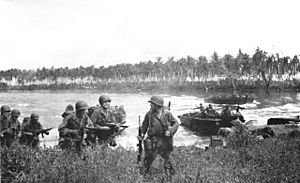 The first wave of US troops lands on Los Negros, Admiralty Islands, 29 February 1944 |
|||||||
|
|||||||
| Belligerents | |||||||
| Commanders and leaders | |||||||
| Strength | |||||||
| 35,000 | 4,000 | ||||||
| Casualties and losses | |||||||
| 326 killed 1,190 wounded 4 missing |
3,280 killed 75 captured |
||||||
The Admiralty Islands campaign (also called Operation Brewer) was a series of battles during World War II. It took place in the New Guinea campaign. The United States Army's 1st Cavalry Division fought to take the Admiralty Islands from Japanese forces.
Reports from airmen suggested the islands were empty. Because of this, General Douglas MacArthur decided to attack sooner than planned. He ordered a quick "reconnaissance in force" (a strong scouting mission). The campaign began on February 29, 1944. Troops landed on Los Negros, one of the larger islands.
The American forces surprised the Japanese by landing on a small, unexpected beach. But the islands were not empty at all! A fierce battle followed. The Allies eventually sent many more troops and supplies. This allowed the 1st Cavalry Division to take control of the islands. The campaign officially ended on May 18, 1944.
This victory helped to cut off the main Japanese base at Rabaul. This base was a key target for the Allies. The Admiralty Islands then became a major air and naval base. It was an important starting point for later battles in the Pacific.
Contents
Background of the Conflict
Island Geography
The Admiralty Islands are about 200 miles (320 km) northeast of New Guinea. They are 360 miles (580 km) west of Rabaul. The weather is tropical, with high heat and humidity. Heavy rain and thunderstorms are common.
The biggest island is Manus Island. It is about 49 miles (79 km) long and 16 miles (26 km) wide. The middle of the island has mountains covered in thick rainforest. The coast has many reefs and mangrove swamps. Los Negros is a smaller island next to Manus. It has two important harbors: Papitalai and Hyane. These are separated by a narrow strip of land. Los Negros forms a natural barrier for Seeadler Harbour. This large harbor is important for ships.
Allied Battle Plans
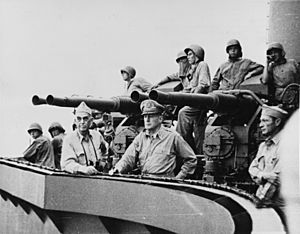
In 1942, Allied leaders decided to attack the Japanese base at Rabaul. This base was blocking their advance towards the Philippines. The main goal was to reduce the threat from Japanese planes and ships. The Pacific theatre was divided into two areas. General Douglas MacArthur led the South West Pacific Area. Admiral Chester W. Nimitz led the Pacific Ocean Areas.
By 1943, the Allies considered bypassing Rabaul instead of capturing it directly. They still needed a forward naval base. The Admiralty Islands were perfect for this. They had flat areas for airfields and a large harbor for ships. On August 6, 1943, the Allies decided to neutralize Rabaul. They planned to invade the Admiralty Islands on June 1, 1944.
In January 1944, Allied planes attacked Rabaul. The Japanese air defenses weakened. On February 15, New Zealand troops landed on the Green Islands, close to Rabaul. On February 16-17, the US Pacific Fleet attacked the main Japanese base at Truk. Many Japanese planes were sent to defend Truk.
General MacArthur then ordered the invasion of the Admiralty Islands for April 1. This was called Operation Brewer. The plan included 45,000 soldiers, air support, and construction teams. But on February 23, US bombers flew over Los Negros. They reported no enemy activity. Lieutenant General George Kenney suggested taking the islands quickly with a small force. MacArthur agreed, saying, "That will put the cork in the bottle."
Orders went out on February 24, 1944. A reinforced squadron of the 1st Cavalry Division would do a "reconnaissance in force." If the islands were empty, they would be occupied. If the enemy was strong, the force would pull back. General MacArthur and Vice Admiral Thomas C. Kinkaid went along to make the decision.
The force was led by Brigadier General William C. Chase. It included 1,026 troops. They were carried on fast transport ships and destroyers. The force also included Australian soldiers. They would help with local people and intelligence. MacArthur chose the 5th Cavalry because they were known for their fighting spirit.
However, Allied intelligence did not agree that the islands were empty. They reported 3,000 Japanese troops there on February 15. By February 24, they estimated 4,000. They believed the Japanese were saving ammunition. Six Alamo Scouts were sent to Los Negros on February 27. They reported the south coast was "lousy with Japs."
Japanese Defenses
The Japanese forces in the Admiralties were part of the Japanese Eighth Area Army. This army was based at Rabaul. In September 1943, Japan decided to shorten its defensive line in the Pacific. General Hitoshi Imamura was ordered to hold his part of the line as long as possible. This would give the Japanese navy and army time to prepare. Holding the Admiralties was very important. If the Allies took them, their bombers could reach the key Japanese base at Truk.
Imamura asked for more troops for the Admiralties. But no infantry division was available. Other requests for troops were also turned down. In January 1944, Japan agreed to send the 66th Regiment. But the ship carrying reinforcements was sunk by a US submarine.
At the time of the Allied landing, Japanese forces were led by Colonel Yoshio Ezaki. He commanded the 51st Transport Regiment. Other units included the 2nd Battalion, 1st Independent Mixed Regiment, and the 1st Battalion, 229th Infantry Regiment. Allied intelligence knew about these units. The 1st Battalion, 229th Infantry Regiment, was experienced but lacked equipment. The 2nd Battalion, 1st Independent Mixed Regiment, had new, less experienced soldiers.
The Japanese had built an airstrip at Lorengau. They also started another, called Momote Airstrip, on Los Negros. By February, both airstrips were not usable. The anti-aircraft guns were silent to save ammunition and hide their positions. Ezaki ordered his men not to move or fire during the day.
Battle of Los Negros
The Landing
The Allies chose a small beach on the south shore of Hyane Harbour for the landing. This was near the Momote airstrip. The airstrip could be taken quickly. But the area was surrounded by mangrove swamps. The harbor entrance was very narrow. This was a risky plan, but it worked. The Japanese did not expect a landing there. Most of their forces were defending the beaches of Seeadler Harbour.
On February 29, 1944, the weather was cloudy. This prevented most of the planned air strikes. Only a few bombers found their target. The naval bombardment was extended for 15 minutes. The first wave of troops landed at 8:17 AM without problems. But once the bombing stopped, Japanese soldiers came out. Machine guns and shore batteries began firing.
The landing craft returning for more troops came under heavy fire. The second wave had to turn back until destroyers silenced the enemy guns. The third and fourth waves also faced fire. A reporter described the scene: "Machine-gun fire over our heads. Our light landing craft shuddered... As we made the turn for the beach, something solid plugged into us." Four of the 12 landing craft were damaged. The last destroyer was unloaded by 12:50 PM. The Navy lost two men and had three wounded.
It was safer on shore. The cavalrymen quickly took the airstrip. They set up machine guns and unloaded supplies. Two soldiers were killed and three wounded. At 4:00 PM, General MacArthur and Admiral Kinkaid came ashore. MacArthur decided to stay. He ordered General Chase to hold the position until more troops arrived. Then he returned to his ship.
Fighting for the Beachhead
General Chase pulled his troops into a tight defensive area. The ground was hard coral, which made digging foxholes difficult. Machine guns were placed on the front line. Japanese groups tried to sneak in all night. An airdrop of ammunition was requested. Three B-25 bombers dropped supplies at 8:30 AM. Four B-17s dropped blood plasma, ammunition, and barbed wire.
The Japanese were not expected to attack until dark. But around 4:00 PM, a Japanese patrol was found inside the American lines. They had gotten very close to General Chase's command post. A sniper fired at the post. Fifteen dead Japanese officers and sergeants were found, including Captain Baba, their commander. The Japanese launched another attack at 5:00 PM but could not break through.
The next morning, more Allied forces arrived. Six LSTs (Landing Ships, Tank) came with more troops and equipment. They came under mortar fire as they landed. General Chase ordered an attack to make the defensive area larger. B-25 bombers attacked Japanese positions. Japanese fighters tried to stop them but were driven off.
Both squadrons of the 5th Cavalry attacked at 3:00 PM. They took all their targets and set up a new, larger defensive line. The 40th Naval Construction Battalion (Seabees) had landed to work on the airstrip. Instead, they used their equipment to clear areas for firing and build defenses. They even defended a part of the perimeter themselves.
Japanese guns on Hauwei Island prevented Allied minesweepers from entering Seeadler Harbour. Allied destroyers bombarded the island. The Japanese guns stopped firing but started again when the minesweepers tried to enter. The destroyers then bombarded Japanese guns covering Hyane Harbour. This allowed the LSTs to leave safely.
General Walter Krueger was worried about the situation on Los Negros. He sped up the arrival of the rest of the 1st Cavalry Division. Krueger knew Hyane harbor was too small for the whole division. He needed to open Seeadler Harbour. This would allow landings on Manus Island.
The Japanese also faced problems. They had expected a landing at Seeadler Harbour. Most of their forces were around the Lorengau airfield. Colonel Ezaki ordered an attack on the Hyane beachhead. But he suspected it was a trick. He held back some troops. By March 2, Ezaki decided to attack Hyane with all his forces. But bad terrain and Allied shelling delayed the attack until March 3.
At 9:00 PM, a Japanese plane dropped bombs, cutting telephone wires. Then, a Japanese infantry attack began, supported by mortars. Offshore, Allied destroyers were attacked by Japanese bombers. The 1st Squadron, 5th Cavalry, was attacked by about two platoons. They faced heavy machine gun and mortar fire. The main Japanese attack came from the 2nd Battalion, 1st Independent Mixed Regiment. They advanced openly, even talking and singing. They ran into mines and booby traps, then into American machine gun fire.
Japanese barges tried to cross Hyane harbor but were stopped by anti-aircraft guns. A Bofors 40 mm gun position was captured by the Japanese but quickly retaken by the Seabees. The 5th Cavalry's machine gunners killed so many Japanese that they had to move their guns to get clear shots. Sergeant Troy McGill fought bravely in a trench with his squad. All were killed or wounded except McGill and one other man. McGill fired his rifle until it jammed, then fought with it until he was killed. He was given the Medal of Honor for his bravery.
By dawn, the Japanese attack ended. Over 750 Japanese dead were counted. American casualties were 61 dead and 244 wounded. General Chase called for more ammunition.
Securing Seeadler Harbour
On March 4, the 2nd Squadron, 7th Cavalry, arrived and took over from the 5th Cavalry. The next day, Major General Innis P. Swift, commander of the 1st Cavalry Division, arrived and took command. He ordered an attack across the native skidway. The 5th Cavalry went back into the fight. The Japanese launched a daylight attack, but it was pushed back. The American attack was delayed. It ran into a Japanese minefield.
On March 6, another convoy arrived at Hyane Harbour. It brought the 12th Cavalry and more equipment, including tanks and howitzers. The 12th Cavalry was ordered to capture the Salami Plantation. The road was muddy and blocked by the Japanese. An Australian guide helped the 12th Cavalry and three tanks reach Salami. The Japanese fought fiercely there for over an hour. The tanks fired shells into buildings and bunkers.
Local people told the Australians that the Japanese had gone to Papitalai Mission. This became the next target. The 5th Cavalry attacked Papitalai Plantation from the east. The 2nd Squadron, 12th Cavalry, attacked Papitalai Mission. The 5th Cavalry took Porlaka easily.
Landing craft could not be used at Papitalai Mission because of the coral reef. Only two of five special landing vehicles (LVTs) were ready in time. The attack went ahead anyway, with air and artillery support. The first wave had to hold its position for 45 minutes under fire. Later, they fought off a counterattack. The LVTs made 16 trips, bringing troops, supplies, and evacuating the wounded.
Colonel Ezaki reported the attack to Rabaul. He promised a night counterattack, but it never happened. The Japanese withdrew.
The task of silencing the Japanese guns guarding Seeadler Harbour fell to Rear Admiral Victor Crutchley's Task Force 74. They bombarded Hauwei Island for an hour on March 4. But on March 6, a US destroyer was hit by a Japanese shell from Hauwei. Admiral Kinkaid ordered another attempt. On March 7, Task Force 74 heavily bombarded Hauwei and other islands. The next day, two destroyers and minesweepers entered Seeadler Harbour without being fired upon. This opened the way for the 2nd Brigade, 1st Cavalry Division, to land at Salmi on March 9.
By March 7, the Seabees had the Momote airfield ready. Artillery spotting planes began using it on March 6. Twelve P-40 Kittyhawks from the Royal Australian Air Force (RAAF) arrived on March 9. More RAAF planes arrived over the next two weeks. Air support was now just minutes away.
The Australian New Guinea Administrative Unit (ANGAU) found the town of Mokerang on March 9. They found 50 people there. The Japanese had taken their food. ANGAU arranged for the Americans to provide food for them.
Battle of Manus
Hauwei Island Attack
Operations on Los Negros were now mostly clean-up. But about 2,700 Japanese troops were still on Manus. General Swift decided to land the 2nd Brigade at Lugos Mission, west of Lorengau. Lorengau was a key target with an airfield and roads. First, the 302nd Cavalry Reconnaissance Troop scouted for artillery positions.
On March 11, three patrols were sent out. One found Bear Point on Manus empty. Another found the Butjo Luo Islands empty. The third patrol went to Hauwei. As they landed, they found a hidden Japanese bunker. When they threw grenades, hidden Japanese mortars and machine guns opened fire. Eight Americans were killed and fifteen wounded.
General Swift delayed the landing on Lugos. He ordered the 2nd Squadron, 7th Cavalry, to capture Hauwei. The landing was covered by destroyers, rockets, artillery, and RAAF Kittyhawks. The cavalrymen found strong Japanese bunkers with good firing positions. The next morning, a tank was brought over. The Japanese had no answer for it. The cavalrymen overcame the defenders. They lost eight killed and 46 wounded. 43 Japanese were killed. The artillery battalions then moved to Hauwei and Butjo Luto.
Lorengau Capture
The attack on Manus began on March 15. Two troops of the 8th Cavalry Regiment crossed Seeadler Harbour from Salami. Beaches at Lugos, west of Lorengau, were chosen. They were less defended than those closer to Lorengau. Destroyers, rockets, artillery, and B-25 bombers bombarded the area.
The Japanese did not expect a landing at Lugos. Their positions were quickly taken. The 1st Squadron, 8th Cavalry, advanced east. They were stopped by a Japanese bunker complex near the Lorengau airstrip. After artillery and air strikes, the cavalry advanced and took a ridge overlooking the airstrip. The 7th Cavalry landed at Lugos and took over its defense. This freed the 2nd Squadron, 8th Cavalry, to join the attack on Lorengau.
The first attempt to capture the airstrip was stopped. A second attempt on March 17, with tanks, made good progress. Lorengau itself fell on March 18.
The main Japanese force on Manus had not been found yet. The 7th Cavalry found it on March 20, inland near Rossum. Six days of fighting were needed to defeat the Japanese there. Their bunkers were strong and hard to destroy with artillery.
Outlying Islands
On Los Negros, the Japanese ran out of food and ammunition. Organized Japanese resistance ended on March 24. This left several other islands in Japanese hands. To protect civilians, ANGAU quietly moved them before American operations.
Pityilu Island was believed to have about 60 Japanese. On March 30, the 1st Squadron, 7th Cavalry, landed there. The landing was covered by destroyers, artillery, and air strikes. The landing was unopposed. But a strong Japanese position was found and overcome with tanks and artillery. 59 Japanese were killed. Eight Americans were killed and six wounded.
Ndrilo and Koruniat islands were attacked on April 1. But the 1st Squadron, 12th Cavalry, found them empty. This was the only amphibious operation of the war using dugout canoes. The final landing was on Rambutyo on April 3. Six landing craft and six smaller boats were used. The first waves landed on a reef, and troops had to wade ashore. Luckily, there was no opposition. The Japanese were hiding inland. ANGAU found them, and 30 Japanese were killed and five captured.
American patrols continued to hunt for Japanese throughout the islands. Natives often reported sightings. On Los Negros, the 302nd Cavalry Reconnaissance Troop killed 48 Japanese and captured 15 in May. On Manus, 586 Japanese dead were counted and 47 prisoners taken. General Krueger officially declared the campaign over on May 18.
Japanese Perspective
A diary found on a dead Japanese soldier showed his last days:
28 March. Last night's duty was rather quiet except for the occasional mortar and rifle fire that could be heard. According to the conference of the various unit leaders, it has been decided to abandon the present position and withdraw. The preparation for this has been made. However, it seems as though this has been cancelled and we will firmly hold this position. Ah! This is honorable defeat and I suppose we must be proud of the way we have handled ourselves. Only our names will remain, and this is something I don't altogether like. Yes, the lives of those remaining, 300 of us, are now limited to a few days.
30 March. This is the eighth day since we began the withdrawal. We have been wandering around and around the mountain roads because of the enemy. We have not yet arrived at our destination but we have completely exhausted our rations. Our bodies are becoming weaker and weaker, and this hunger is getting unbearable.
31 March. Although we are completely out of rations, the march continues. When will we reach Lorengau? Or will this unit be annihilated in the mountains? As we go along, we throw away our equipment and weapons one by one.
1 April. Arrived at native shack. According to a communication, friendly troops in Lorengau cannot help but withdraw. Hereafter there is no choice but to live as the natives do.
Base Development
Airbase Construction
The Momote airfield was built on a coral base. The Japanese had added a thin layer of coral. This was not strong enough for heavy use. So, the 40th Naval Construction Battalion and other units had to remove the top layer and lay a new coral surface. The runway was extended to 7,800 feet (2,400 m) by late April. B-24 bombers began using it on April 18, 1944.
Plans for a second airfield at Salami Plantation were changed. A new site was found near Mokerang. The 836th Engineer Aviation Battalion built the runway. Other units built taxiways and parking areas. They had to remove 1,100 acres (4.5 km²) of land and 18,000 coconut trees. B-24 bombers arrived on April 21, 1944. They took part in raids on Biak.
A fighter base for repairing aircraft was built on Ponam Island. Half of the area was swamp, so coral was brought in to fill it. Another facility for carrier aircraft was built on Pityilu Island. It also had housing for 2,500 men. A recreation center for up to 10,000 men was built on Pityilu.
The 2nd Naval Construction Regiment built the naval base on Los Negros. This included storage for 500,000 barrels (80,000 m³) of fuel oil. They also built a 500-bed hospital, two wharves for cargo ships, and many warehouses and administration buildings. At Lombrum Point, the Seabees built repair bases for seaplanes, ships, and landing craft. A floating drydock was also provided.
The 5th Naval Construction Regiment developed facilities on Manus. They built 128 storage buildings and 50 refrigerators. A water supply system was built to provide 4 million US gallons (15 million L) of water per day. This included water treatment plants and reservoirs. All construction was finished by April 1945. The base was used until the end of the war.
Casualties
General Krueger reported that 3,280 Japanese soldiers were killed. 75 were captured. About 1,100 more were missing. American casualties were 326 killed, 1,189 wounded, and four missing. About 1,625 Americans were evacuated for all reasons, including wounds and illness. One Australian was wounded. ANGAU reported one native killed and one wounded in action. Three were killed by the Japanese. 20 were accidentally killed and 34 wounded by Allied attacks.
See Also
- Admiralty Islands campaign order of battle
- Manus Naval Base


